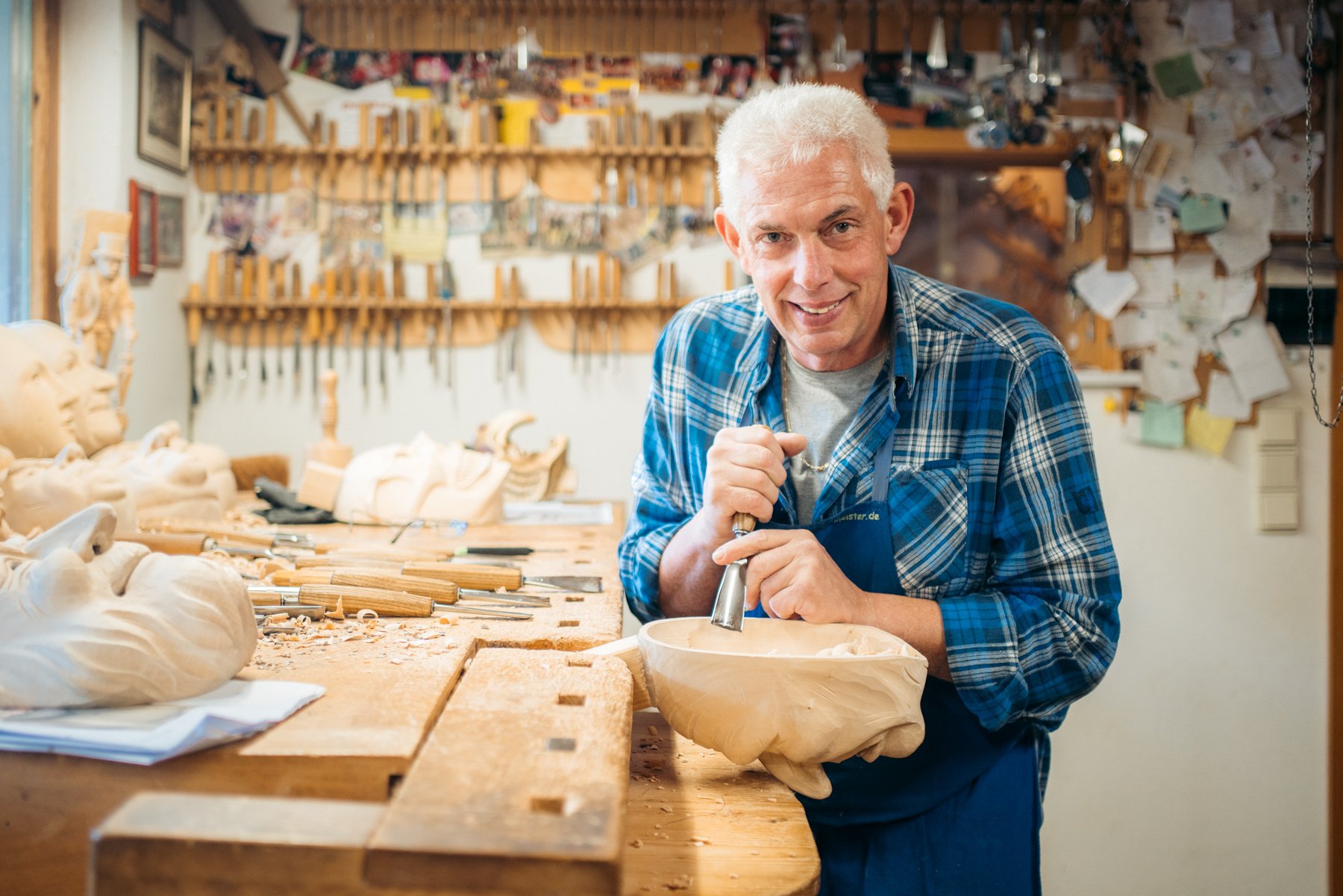Inside the workshop of Triberg’s Master wood sculptor: The Fasnet masks of Samuel Kammerer
Idyllic. That's what comes to mind as we drive the narrow roads just outside of Triberg, surrounded by lush forest and babbling streams. A bit of morning fog remains as we exit the car and feel the chill of the November air envelop us. We have arrived at Samuel Kammerer's home workshop, where we will spend the next few hours chatting and learning about his path to becoming a master wood sculptor (Holzbildhauermeister).
Samuel Kammerer in his home workshop in Triberg
For more than thirty years, Samuel has been carving Fasnet masks, cuckoo clocks, and nativity scenes (cribs) from his home in Triberg, Germany. He also carves prosthetic hands for children on behalf of a company based in Munich. The son of a carpenter (Scheiner), he developed an interest in woodworking early on, but did not want to follow in his father's footsteps and make furniture. Instead, he fell in love with the smaller, more intricate pieces.
In 1980, he became an apprentice wood sculptor, then sat for his Journeyman examinations (wood theory) in 1983, before receiving his Master's in wood sculpture in 1989. The time between his Journeyman examinations and receiving his Master's was spent putting in hours upon hours working with wood, honing his craft, and deciding his specialty within woodworking.
Although he has traveled to showcase his work and provide demonstrations, Samuel is a native of Triberg, born and raised, and still spends the majority of his time there. His workshop is located at his home, and he also has a storefront in Triberg, where you can purchase a wide range of his woodwork, masks, cuckoo clocks, and other unique gifts.
Masks on display in Samuel Kammerer’s home workshop
Fasnet ("Fasnacht", also known as Fasching or Carnival)
Fifty percent of Samuel's work involves carving masks. He works with thirty Fasnet guilds throughout the Black Forest, carving masks for new members when they join, and making occasional repairs to masks that may have been dropped or scratched during the parades. He proudly shared that his masks will last a lifetime.
"Fasnet" is the name for the Swabian-Alemannic carnival celebrated in southwestern Germany, Switzerland, Alsace, and parts of Austria, which begins in January, as opposed to the more traditional Carnival activities that start in November. It is a pre-Lenten festival with ancient traditions, often involving elaborate costumes called "Häs," and a stark contrast to the more modern-day "Karneval" celebrated in other regions of Germany. The term is a regional variant of "Fastnacht," which literally translates to "Fasten-Nacht," or "eve of the fast”.
Carnival parade in Talheim, Germany
Samuel himself enjoys participating in the local Fasnet activities, donning the character of the “Spättle” and joining in on the local parades in his “häs”, throwing confetti and candy into the crowds. Other notable Fasnet characters from Triberg include the Triberger devil (the oldest existing mask dates to 1893), the Red Fox, and the Featherbeak.
The Process
When someone commissions Samuel for a mask, he works with them to bring a concept to life. Oftentimes, if they are a member of a Fasnet guild, they already have an idea of what they want. Some towns stick to specific designs based on their history and Black Forest folklore, so you don’t get to choose your own costume. Others are more diverse, and you can come up with your own idea. They dive into the folklore of the town to bring the concept to life. Previously, the designs were hand-drawn, and then Samuel got to work. He informed us that now, he is utilizing AI tools to bring the visual to life, then carves based on the rendered image. He said this process has saved him a lot of time.
Samuel shows us a carving based on an AI rendered image
Once he has finalized the sketch, he gets to work, hand-carving from a solid block of wood, spending three to four days perfecting the carving (in contrast to a week for a cuckoo clock). If it's a mask that will be replicated in the future, he can use a machine to replicate future masks. With the machine, it takes him approximately two days to finalize each one. Once he is done carving the mask, it is sent out for painting as he does not do that part himself.
Samuel utilizes wood from the Alsace region, as the wood local to Triberg is too dark and often contains a lot of sap, making it unsuitable for wood carving and painting. The wood from Alsace is from a linden tree, typically used for flower tea. He explained that the demand for that tea has lowered, so it's a good fit for his carvings since there are a lot of linden trees in Alsace. The wood is light, almost white, making it ideal for painting, and it is soft enough for carving.
The Future
When asked about the future of this centuries-old craft, his answer was bleak. He hasn't had a student come to intern or study under him for more than eight years. He has two sons, 25 and 30, who both know how to carve, but have decided to pursue their own career paths. Because it is so time-intensive, requiring a lot of hours on your feet, and you work for a few years without receiving substantial pay, newer generations are not interested in pursuing this skill as a profession. Although he hopes his sons might return to wood sculpting in the future, he only wants them to be happy and make their own way in the world.
Samuel’s storefront in Triberg
Although the future of traditional wood carving in Germany appears uncertain, Samuel remains hopeful that it will endure. He no longer hosts large groups at his home workshop, but he still enjoys it when clients visit and get to see the amount of work and care that goes into each mask. "When someone sees me working on their project, it makes them truly appreciate how much time and effort go into each piece, and they can see with their own eyes where it's coming from".
Find this post helpful?
Pin it for later!











